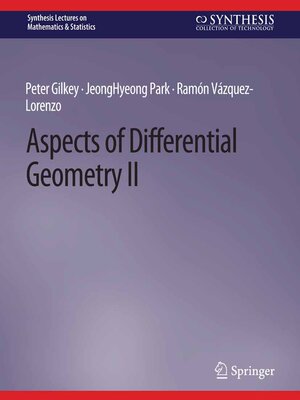Aspects of Differential Geometry II
ebook ∣ Synthesis Lectures on Mathematics & Statistics
By Peter Gilkey

Sign up to save your library
With an OverDrive account, you can save your favorite libraries for at-a-glance information about availability. Find out more about OverDrive accounts.
Find this title in Libby, the library reading app by OverDrive.



Search for a digital library with this title
Title found at these libraries:
| Library Name | Distance |
|---|---|
| Loading... |
Differential Geometry is a wide field. We have chosen to concentrate upon certain aspects that are appropriate for an introduction to the subject; we have not attempted an encyclopedic treatment. Book II deals with more advanced material than Book I and is aimed at the graduate level. Chapter 4 deals with additional topics in Riemannian geometry. Properties of real analytic curves given by a single ODE and of surfaces given by a pair of ODEs are studied, and the volume of geodesic balls is treated. An introduction to both holomorphic and Kähler geometry is given. In Chapter 5, the basic properties of de Rham cohomology are discussed, the Hodge Decomposition Theorem, Poincaré duality, and the Künneth formula are proved, and a brief introduction to the theory of characteristic classes is given. In Chapter 6, Lie groups and Lie algebras are dealt with. The exponential map, the classical groups, and geodesics in the context of a bi-invariant metric are discussed. The de Rham cohomology ofcompact Lie groups and the Peter—Weyl Theorem are treated. In Chapter 7, material concerning homogeneous spaces and symmetric spaces is presented. Book II concludes in Chapter 8 where the relationship between simplicial cohomology, singular cohomology, sheaf cohomology, and de Rham cohomology is established. We have given some different proofs than those that are classically given and there is some new material in these volumes. For example, the treatment of the total curvature and length of curves given by a single ODE is new as is the discussion of the total Gaussian curvature of a surface defined by a pair of ODEs.







